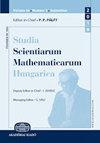“Less” Strong Chromatic Indices and the (7, 4)-Conjecture
IF 0.6
4区 数学
Q4 MATHEMATICS
引用次数: 1
Abstract
A proper edge coloring of a graph 𝐺 is strong if the union of any two color classes does not contain a path with three edges (i.e. the color classes are induced matchings ). The strong chromatic index 𝑞(𝐺) is the smallest number of colors needed for a strong coloring of 𝐺. One form of the famous (6, 3)-theorem of Ruzsa and Szemerédi (solving the (6, 3)-conjecture of Brown–Erdős–Sós) states that 𝑞(𝐺) cannot be linear in 𝑛 for a graph 𝐺 with 𝑛 vertices and 𝑐𝑛 2 edges. Here we study two refinements of 𝑞(𝐺) arising from the analogous (7, 4)-conjecture. The first is 𝑞 𝐴 (𝐺), the smallest number of colors needed for a proper edge coloring of 𝐺 such that the union of any two color classes does not contain a path or cycle with four edges, we call it an A-coloring . The second is 𝑞 𝐵 (𝐺), the smallest number of colors needed for a proper edge coloring of 𝐺 such that all four-cycles are colored with four different colors, we call it a B-coloring . These notions lead to two stronger and one equivalent form of the (7, 4)-conjecture in terms of 𝑞 𝐴 (𝐺), 𝑞 𝐵 (𝐺) where 𝐺 is a balanced bipartite graph. Since these are questions about graphs, perhaps they will be easier to handle than the original special (7, 4)-conjecture. In order to understand the behavior of 𝑞 𝐴(𝐺) and 𝑞 𝐵(𝐺), we study these parameters for some graphs. We note that 𝑞 𝐴 (𝐺) has already been extensively studied from various motivations. However, as far as we know the behavior of 𝑞 𝐵 (𝐺) is studied here for the first time.“少”强色指数与(7,4)-猜想
如果任意两个颜色类的并集不包含具有三条边的路径(即颜色类是诱导匹配),则图𝐺的适当边着色是强的。强着色指数𝑞(𝐺)是强烈着色𝐺所需的最小颜色数。著名的(6,3)定理的一种形式的Ruzsa和szemerdi(解决Brown-Erdős-Sós的(6,3)猜想)表明,对于具有𝑛顶点和𝑐𝑛2条边的图形𝐺,𝑞(𝐺)在𝑛中不可能是线性的。这里我们研究了由类似的(7,4)猜想引起的𝑞(𝐺)的两个改进。第一个是𝑞(𝐺),对于𝐺的适当的边着色所需的最小颜色数,使得任意两个颜色类的并集不包含有四条边的路径或循环,我们称之为a -着色。第二个是𝑞(𝐺),为𝐺的正确边缘着色所需的最小颜色数,这样所有四个循环都用四种不同的颜色着色,我们称之为b着色。这些概念导致了(7,4)-猜想的两个更强的和一个等价的形式,在𝑞(𝐺),𝑞(𝐺)中,𝐺是一个平衡的二部图。由于这些是关于图的问题,也许它们会比原来的特殊(7,4)猜想更容易处理。为了理解𝑞变量变量(𝐺)和𝑞变量变量(𝐺)的行为,我们对一些图的这些参数进行了研究。我们注意到𝑞(𝐺)已经从不同的角度进行了广泛的研究。然而,据我们所知,本文首次研究了𝑞(𝐺)的行为。
本文章由计算机程序翻译,如有差异,请以英文原文为准。
求助全文
约1分钟内获得全文
求助全文
来源期刊
CiteScore
1.30
自引率
0.00%
发文量
19
审稿时长
>12 weeks
期刊介绍:
The journal publishes original research papers on various fields of mathematics, e.g., algebra, algebraic geometry, analysis, combinatorics, dynamical systems, geometry, mathematical logic, mathematical statistics, number theory, probability theory, set theory, statistical physics and topology.

 求助内容:
求助内容: 应助结果提醒方式:
应助结果提醒方式:


